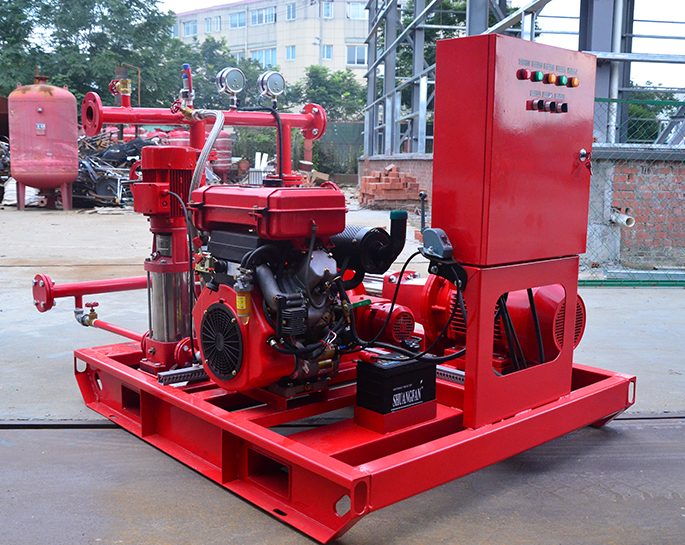What are the potential risks associated with improper installation or maintenance of fire pump sets?
Feb 29, 2024
Share:
Improper installation or maintenance of fire pump sets can pose significant risks to building occupants, property, and overall fire safety. Some potential risks include:
1. **Inadequate Fire Protection:** Improper installation may result in fire pump sets that do not meet the required flow rates, pressure levels, or other performance criteria. This could lead to insufficient water delivery during a fire emergency, delaying suppression efforts and increasing the risk of extensive property damage or loss of life.
2. **System Failure:** Poor maintenance practices can cause wear and tear on critical components of fire pump sets, leading to premature failure. This can result in the complete malfunction of the system when needed most, leaving the building vulnerable to fire hazards.
3. **Non-compliance with Regulations:** Failure to adhere to installation and maintenance requirements specified by building codes, standards, and regulations can result in non-compliance issues. This may lead to penalties, fines, or legal liabilities for building owners and facility managers.
4. **Safety Hazards:** Improperly installed or maintained fire pump sets can pose safety hazards to maintenance personnel and building occupants. Malfunctioning equipment, electrical issues, or leaking fluids may cause accidents, injuries, or exposure to hazardous substances.
5. **Property Damage:** Fire pump failures can result in significant property damage due to delayed or ineffective fire suppression efforts. Water damage from sprinkler systems or other firefighting measures may also occur if the fire pump fails to deliver water properly.
6. **Business Interruption:** Fire incidents and associated property damage can disrupt business operations, leading to financial losses, downtime, and reputational damage for building owners and tenants.
7. **Liability and Litigation:** If inadequate fire protection measures contribute to injuries, fatalities, or property damage during a fire emergency, building owners and facility managers may face legal claims, lawsuits, or insurance disputes.
8. **Loss of Insurance Coverage:** Insurance providers may deny coverage or increase premiums if fire protection systems, including fire pump sets, are not installed or maintained correctly. Non-compliance with insurance requirements can also jeopardize coverage in the event of a fire-related claim.
9. **Negative Public Perception:** Incidents involving fire-related risks or failures can damage the reputation of building owners, facility managers, and businesses associated with the affected property. This can lead to decreased tenant satisfaction, difficulty attracting new tenants, or diminished property value.
To mitigate these risks, it is essential for building owners and facility managers to prioritize proper installation, regular maintenance, and compliance with relevant regulations for fire pump sets and other fire protection systems. Additionally, implementing robust inspection protocols, investing in training for maintenance personnel, and fostering a culture of safety within the organization can help prevent potential hazards associated with fire pump systems.

1. **Inadequate Fire Protection:** Improper installation may result in fire pump sets that do not meet the required flow rates, pressure levels, or other performance criteria. This could lead to insufficient water delivery during a fire emergency, delaying suppression efforts and increasing the risk of extensive property damage or loss of life.
2. **System Failure:** Poor maintenance practices can cause wear and tear on critical components of fire pump sets, leading to premature failure. This can result in the complete malfunction of the system when needed most, leaving the building vulnerable to fire hazards.
3. **Non-compliance with Regulations:** Failure to adhere to installation and maintenance requirements specified by building codes, standards, and regulations can result in non-compliance issues. This may lead to penalties, fines, or legal liabilities for building owners and facility managers.
4. **Safety Hazards:** Improperly installed or maintained fire pump sets can pose safety hazards to maintenance personnel and building occupants. Malfunctioning equipment, electrical issues, or leaking fluids may cause accidents, injuries, or exposure to hazardous substances.
5. **Property Damage:** Fire pump failures can result in significant property damage due to delayed or ineffective fire suppression efforts. Water damage from sprinkler systems or other firefighting measures may also occur if the fire pump fails to deliver water properly.
6. **Business Interruption:** Fire incidents and associated property damage can disrupt business operations, leading to financial losses, downtime, and reputational damage for building owners and tenants.
7. **Liability and Litigation:** If inadequate fire protection measures contribute to injuries, fatalities, or property damage during a fire emergency, building owners and facility managers may face legal claims, lawsuits, or insurance disputes.
8. **Loss of Insurance Coverage:** Insurance providers may deny coverage or increase premiums if fire protection systems, including fire pump sets, are not installed or maintained correctly. Non-compliance with insurance requirements can also jeopardize coverage in the event of a fire-related claim.
9. **Negative Public Perception:** Incidents involving fire-related risks or failures can damage the reputation of building owners, facility managers, and businesses associated with the affected property. This can lead to decreased tenant satisfaction, difficulty attracting new tenants, or diminished property value.
To mitigate these risks, it is essential for building owners and facility managers to prioritize proper installation, regular maintenance, and compliance with relevant regulations for fire pump sets and other fire protection systems. Additionally, implementing robust inspection protocols, investing in training for maintenance personnel, and fostering a culture of safety within the organization can help prevent potential hazards associated with fire pump systems.


.png)
.png)

.png)


